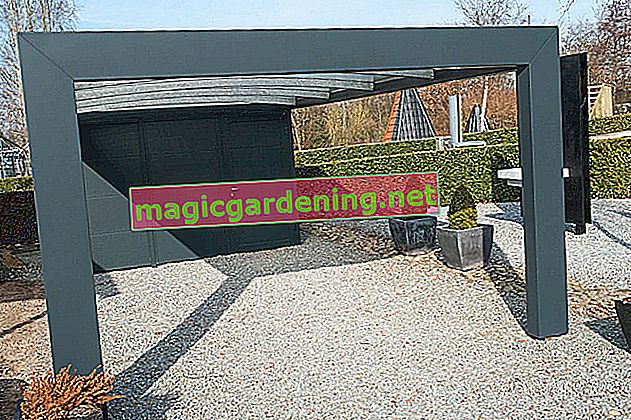
the essentials in brief
- The best way to easily collect rainwater is to use a combination of downpipe, rain collector and water barrel.
- Balcony gardeners collect rainwater with a tarpaulin, funnel, downpipe flap or open rain barrel (€ 4.63 at Amazon *).
- Collecting rainwater is not forbidden in Germany, it is desirable and environmentally friendly. Large-scale collection techniques are subject to approval.
Collecting rainwater - where and how?
Rain makes gardeners' hearts beat faster. After all, rainwater pours thirsty plants and dry lawns for free. In hot summers, the longed-for rain is rare or comes as short-term heavy rain that seeps away uselessly in no time. Anyone who turns on the tap for lush greenery has to pay for it with a juicy water bill. Clever hobby gardeners save money and catch the rain when it falls from the sky. The following table gives an overview of practicable solutions where and how you can collect rainwater:
also read
- How to connect your rain barrel to the gutter
- Put a rain barrel on the balcony
- Connect the rain barrel - that's how it works
| garden | Balcony without a roof | Balcony with roof |
|---|---|---|
| Downpipe | Plans | Downpipe flap |
| Rain collector | Rain barrel | funnel |
Did any of the above options spark your interest? Then read on. The following sections are peppered with solid tips and tricks on how to create a sufficient supply of rainwater as a beginner.
Tips
Collecting rainwater is not prohibited. On the contrary, experts from the Federal Environment Agency expressly recommend the use of rainwater for plants in the garden and on the balcony. However, large water tanks or cisterns are often subject to the regulations of the local building code. In many municipalities, a separate permit is required if excess rainwater is to flow from collecting tanks into the sewer system. An informal request to the regulatory or building authorities removes any ambiguity before you tackle the rainwater collection project.
Collect rainwater with a downpipe - that's how it works

Garden owners with their own homes collect rainwater in the traditional way. For this purpose, an open water barrel is positioned on the house wall. Rain falls on the roof surface, runs into the gutter and a downpipe connected to it, which feeds the rain barrel. This is the simplest and cheapest version to collect rainwater without much effort. The downside of this simple solution is regular flooding, because the rain barrel regularly overflows when it pours from buckets.
The problem solver is a rain collector, also known as a rain thief. The ingenious overflow protection is installed between the downpipe and the rain barrel and directs the valuable water into the collecting container. If continuous or heavy rain overwhelms the capacity of the container, the overflow stop takes effect. Excess rainwater now takes its way through the downpipe into the sewer system. Subsequent installation is possible without any problems. As a further advantage, the rain thief allows a lid for the collecting container because the rain is fed in from the side. This fact optimizes the safety in the family garden because curious children cannot fall into it. Furthermore, the water remains free of impurities and mosquito larvae.
In the luxury version, a practical filter is built in so that bird droppings and other impurities do not get into the collected water. The figure below illustrates the beneficial function of a rain collector with overflow protection on the downpipe.

Collecting rainwater on the balcony - tips & tricks
Balcony gardeners do not have to forego the benefits of rainwater in plant care. Catching rain is easily possible on the balcony. The level of difficulty depends on the general conditions. Different solutions are required on the covered balcony than on a balcony without a roof. Is there access to a downpipe or does it have to work without a downpipe? The three most common ways of collecting rainwater on the balcony are discussed in more detail below:
Collect rainwater without a roof
If you want to collect rainwater on a balcony without a roof and without a downpipe, you are on your own. So far, specialist retailers and tradesmen have not had a convincing solution to offer. Resourceful balcony gardeners are not put off by this. With a tarpaulin and skilled craftsmanship, you can easily create a collecting container for rainwater.
- Stretch the tarpaulin
- Attention: Measure the height so that the stretched tarpaulin with the stone weight is above the rain barrel
- Eyelets connect with anchor points (railings, parasol stands, handles, wall hooks)
- Poke a hole in the middle of the tarpaulin
- Put stone in it
- Place the collecting vessel under the perforated stone recess
Now the rain does not just fall on the balcony floor, but is caught by the tarpaulin and directed over the hollow into the rain barrel. When it's not raining, let the tarpaulin dry and stow it out of sight in a box. Of course, you can simply put an open rain barrel on the balcony to catch the rain. With a stretched tarpaulin, the yield of rainwater increases many times over.
Covered balcony with downpipe

If a downpipe runs in close proximity to the balcony, balcony gardeners will not miss this opportunity. A built-in downpipe flap indicates the direction so that precious rainwater does not rush past unused. Similar to the rain collector from the garden, the rainwater flap is installed in the downpipe and connected to the rain barrel. It can be retrofitted without dismantling the downpipe. When the water barrel is full, the downpipe flap is manually adjusted so that more rain runs into the sewer system.
It is important to note that you must consult with the house owner or the property management company before installing. Tenants are not permitted to intervene in the drainage facilities on the house without prior consultation and permission.
Covered balcony without a downpipe
Imagination and manual skills are required if you want to collect rainwater on a balcony with a roof and without a downpipe. The secret of success is a funnel to enlarge the collecting area on the collecting device. Furthermore, this collecting funnel must be placed outside the balcony roof. This basic concept offers scope for a variety of designs. The following ideas may inspire DIY enthusiasts:
- Funnel : construction made of tubes, clotheslines and rainproof fabric or cut open 5 liter plastic canister
- Extension : telescopic handle with ribbed hose
- Anchor point : wall hook, weighty parasol stand, window handle
The telescopic fruit picker handle from Gardena is well suited for aligning and extending the collecting funnel. At its end there is already a small collecting funnel, which in this case does not pick fruit from the tree top, but rather serves as a support for the large collecting funnel. Ideally, use a flexible ribbed hose that guides the rainwater from the funnel to the collection container. As a rain barrel, we recommend a wide-neck barrel from Noorsk, which is available in numerous sizes and shapes on Amazon.
Digression
Rainwater - good for the soil and plants
Watering with rainwater is not only easy on the wallet. The garden soil, flowers, shrubs and vegetables are also beneficiaries. Rainwater scores with minimal water hardness and does not contain any undesirable additives such as fluorine or chlorine. As a result, neither lime nor other harmful substances can accumulate in the garden soil. In this way, the pH value remains in the correct position without any complex improvement measures. When amateur gardeners water with soft rainwater, exotic plants such as camellias and azaleas blossom. Most of the beauties of flowers in beds, on balconies and windowsills cannot stand hard tap water. Collected rain also improves the vitality and taste of vegetables if the valuable liquid is used regularly as irrigation water.frequently asked Questions
As a carpenter, how can I collect rainwater in the rented apartment?

It is undoubtedly a challenge as a home gardener to water his plants with soft rainwater. There is no access to a downpipe from the rented apartment and there is no balcony to catch raindrops with a tarpaulin or funnel. The only option is to set up a collection container outside when it rains. With an average shower, around 5 liters of rainwater fall from the sky every hour. Experience shows that this amount covers the watering needs of indoor plants in a rented apartment.
Which collection containers are suitable for collecting rainwater on the balcony?
The space on the balcony is tight. The classic 1000 liter rain barrel for the garden is too big and too heavy for this purpose. Furthermore, due to the exposed location, the aesthetic aspect should not be neglected. Half a wine barrel or the rustic wooden tub from the flea market create a rustic ambience. The rain barrel looks elegant in the style of a Greek amphora, complete with lid and tap. A weatherproof wall-mounted tank with a capacity of 300 liters is useful as a rain barrel to save space.
We collect rainwater directly from the downpipe. However, the rain barrel is nowhere near enough to water flowers, shrubs and lawns. What to do?
The capacity can be easily increased by setting up several rain barrels (€ 149.95 at Amazon *) next to each other and connecting them together. First, the rainwater runs through the gutter and downpipe into the first barrel. From there, the adjacent rain barrels automatically fill up via the connection hoses. For the series connection, the containers must be at the same height. Special ribbed hoses, complete with screw connectors and seals, are well suited for the connection.
Tips
You no longer want to stand by and watch as valuable rain simply seeps away on your property? With drainage in the ground, you can catch most of the rainwater, channel it through drainage pipes into a collecting line and from there into a pond, a biotope or a septic tank. The uncomplicated technology has not only proven itself to protect against waterlogging in clay soil. This way, rainwater can be collected on a large scale.








